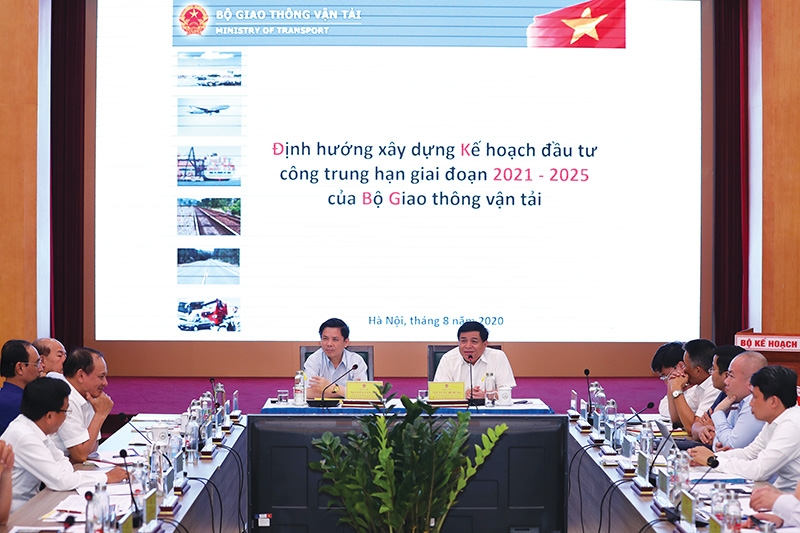Priorities refocused for North-South Expressway
 |
| The two ministries discussed key infrastructure projects for Vietnam’s future growth |
The project will receive a fresh boost from the Ministry of Planning and Investment (MPI), which is determinated to work with relevant ministries and agencies to complete the project by 2025. Notably, the MPI will accompany the Ministry of Transport (MoT) to formulate construction and capital mobilisation plans to implement the key national scheme, connecting the northern province of Lang Son to the southernmost province of Ca Mau.
“The two ministries will together develop a key scheme and two or three backup initiatives to mobilise capital for the project so that the construction can go smoothly. We will have to calculate the state budget to work out plans to mobilise capital either from official development assistance or issuing government bonds,” said MPI Minister Nguyen Chi Dung at last week’s meeting with MoT Minister Nguyen Van The. “Even then, we will also think about the final plan using the entire state budget to serve for construction of the eight sections of the North-South Expressway project.”
Minister Dung said that implementing the expressway must be the topmost priority in the country’s medium-term public investment planning in the next years because the project is crucial in improving national competitiveness and attracting foreign investment.
In addition, it contributes to creating breakthrough growth for the country. Furthermore, it can also be the foundation for other transport infrastructure.
His urging comes after the project fell far behind targets outlined in the medium-term public investment plan for the 2016-2020 period and the 11th Party Central Committee’s Resolution No.13-NQ/TW from 2012 on building a synchronous infrastructure system to turn Vietnam into a modern industrial country by this year.
The blame mainly lies with prolonged investment capital mobilisation procedures as well as delays in land clearance.
The project includes 11 sections, three of which will be funded by the state while the remaining eight sections were supposed to be invested through the public-private partnership (PPP) model.
Just under a year ago, work began on the 98-km Cam Lo-La Son section at an estimated cost of VND7.7 trillion ($331 million). It was the first of the 11 sections to be built for the expressway, which is estimated to cost a total of VND118.7 trillion ($5.11 billion), including VND55 trillion ($2.37 billion) from the state budget. In June, the National Assembly approved to switch three sections (Mai Son-Highway 45, Highway 45-Nghi Son, and Phan Thiet-Dau Giay) into the PPP model.
It is not the first time that the MPI has raised concerns about delays in construction of the national-scale projects. In 2010, the ministry opposed the plan to use VND105 trillion ($4.56 billion) to develop National Road 1A. Instead, it proposed focusing on building the North-South Expressway, otherwise construction may be delayed by 20 years.
A decade since it began, only one-third of the project has been completed and Minister Dung reaffirmed his forecast by saying with the current progress and the unscrupulous investment plan, Vietnam will be hard-pressed to finish the expressway by 2030.
“We need a breakthrough for the project. We need cooperation between ministries, the State Bank of Vietnam, and higher levels to build specific annual, five-year, and 10-year construction plans,” Minister Dung said. “After each period, we have to view specific advantages and disadvantages.”
Emphasising the importance of the North South Expressway, he added, “The MPI can advise the government about mobilising funds. The most important thing is the determination of the relevant authorities to take the project into operation by 2025.”
What the stars mean:
★ Poor ★ ★ Promising ★★★ Good ★★★★ Very good ★★★★★ Exceptional
Related Contents
Latest News
More News
- Global partnerships key to Vietnam’s IFC development (December 26, 2025 | 16:18)
- Vingroup pulls out of bid to invest in North-South high-speed railway (December 26, 2025 | 11:42)
- Strengthening supply chains through trade promotions and customs reform (December 24, 2025 | 14:00)
- PM orders investment model for North–South high-speed rail (December 22, 2025 | 17:43)
- LS Eco Energy to invest in Vietnam rare earth sector (December 22, 2025 | 17:31)
- Government moves to establish International Financial Centre (December 21, 2025 | 21:00)
- Vietnam's IFC to target global investment flows (December 21, 2025 | 18:00)
- Two national hospitals expand capacity with new facilities (December 20, 2025 | 09:00)
- Ha Tinh breaks ground on major Vingroup industrial and energy projects (December 19, 2025 | 18:24)
- EVN launches major power infrastructure projects nationwide (December 19, 2025 | 18:17)

 Tag:
Tag:





















 Mobile Version
Mobile Version